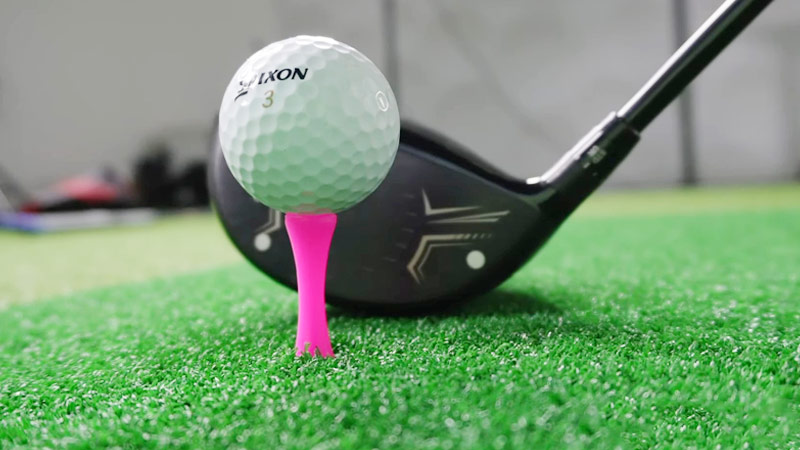When it comes to golf, the setup is the foundation for a successful swing, and it all begins with how your golf driver sits on the ground.
The placement of your driver’s head can significantly impact the trajectory and distance of your tee shots. In this comprehensive guide, we’ll explore the nuances of achieving the ideal driver setup.
From tee height to clubhead position, we’ll delve into the key elements that determine how your driver should sit on the ground.
Whether you’re a seasoned golfer looking to refine your setup or a beginner eager to learn the fundamentals, this post will equip you with the knowledge and techniques needed to maximize your potential off the tee.
How Should a Golf Driver Sit on the Ground?
There is common confusion about how should a golf driver sit on the ground. A golf driver should sit on the ground in a specific manner to help golfers achieve the best results when teeing off.
Here’s how a golf driver should be positioned on the ground:
Address Position
When addressing the golf ball with a driver, your feet should be shoulder-width apart, and the ball should be positioned just inside your lead heel (the left heel for a right-handed golfer and the right heel for a left-handed golfer).
Tee Height
Use a tee to elevate the golf ball above the ground. For a driver, the ball should be teed up so that approximately half of the ball is above the crown (top) of the clubhead.
This allows you to hit the ball on the upswing, which is important for maximizing distance with a driver.
Clubhead Placement
The clubhead of the driver should be positioned behind the golf ball.
The leading edge of the clubface should be parallel to the target line or slightly open to accommodate the natural swing path of a driver, which is typically from the inside out.
Angle of Attack
With a driver, you want to hit the ball on the upswing, so your clubhead should approach the ball on a slightly ascending angle. This promotes a high launch and lower spin, which can lead to longer drives.
Make sure the bottom of the clubhead is slightly off the ground when you address the ball to allow for this upward angle of attack.
Ball Position
The ball should be aligned with your lead heel (left heel for right-handed golfers, right heel for left-handed golfers).
The exact ball position can vary depending on your swing and setup, but having the ball forward in your stance encourages an upward strike on the ball.
Stance and Posture
Maintain a good golf stance and posture. Keep your spine relatively straight, and bend forward from your hips.
Your upper body should tilt slightly away from the target, and your weight should be balanced between your feet.
Grip
Hold the club with a neutral grip, and ensure that your hands are positioned correctly on the club’s grip.
Remember that these guidelines are general and may need to be adjusted based on your individual swing and preferences.
It’s a good idea to work with a golf instructor to fine-tune your driver setup and ensure that it suits your swing and maximizes your driving performance.
Should the Driver Sit Flat at the Address?
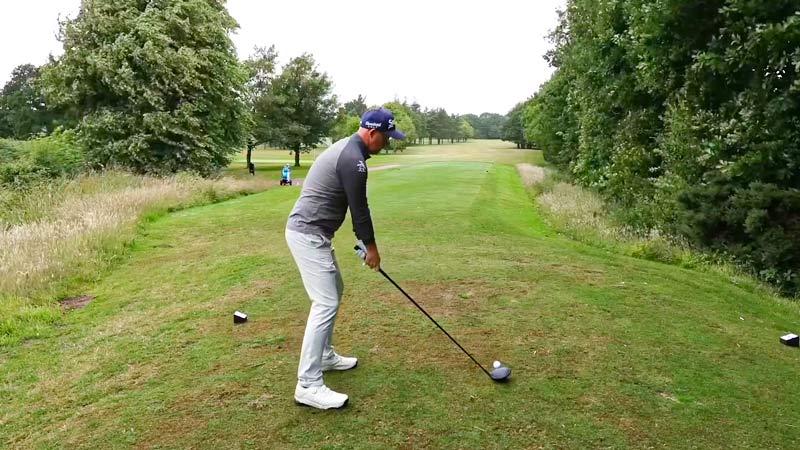
You might also find it confusing about how the should driver sit at the address. No, the driver should not sit flat on the ground at the address.
The clubhead of a driver should be positioned slightly off the ground, with the leading edge of the clubface parallel to the ground or slightly open, and the bottom of the clubhead hovering just above the turf.
This setup is important for several reasons:
Angle of Attack
With a driver, you want to hit the ball on the upswing. This is different from irons, where you typically strike the ball on a descending angle.
By hovering the driver slightly above the ground, you set up the conditions for an upward angle of attack, which promotes a high launch and lower spin, resulting in longer drives.
Tee Height
You use a tee to elevate the ball for a driver shot. The ball should be teed up so that approximately half of it is above the crown (top) of the clubhead. This means the driver’s head must be positioned slightly off the ground.
Swing Path
The natural swing path with a driver is often from the inside out. If the driver were to sit flat on the ground, it could lead to a steep, descending strike that is not conducive to maximizing distance with a driver.
Address Position
Having the driver slightly off the ground allows you to position the ball forward in your stance, which is desirable for hitting up on the ball.
So, when addressing the ball with a driver, make sure the clubhead hovers slightly above the turf, ensuring the bottom of the clubhead doesn’t make contact with the ground at the address.
This setup encourages the correct angle of attack and promotes the optimal conditions for long and accurate drives.
The Basics of Golf Driver Setup
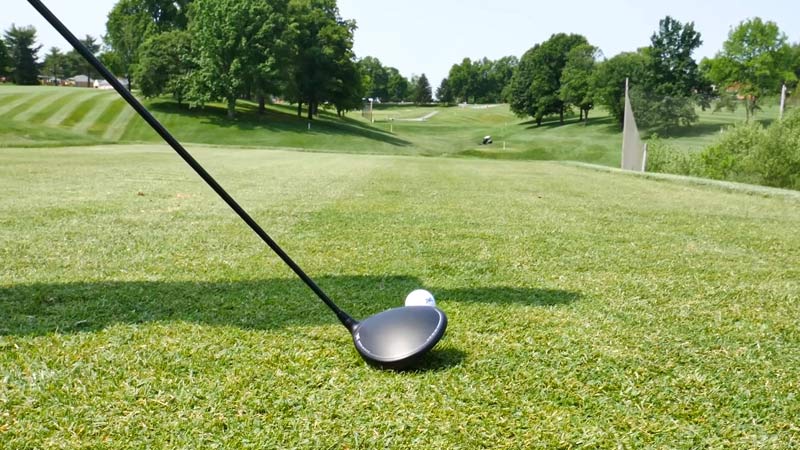
The setup with a golf driver is crucial for achieving long and accurate drives. Here are the basic elements of a golf driver setup:
Stance and Ball Position
- Stand with your feet shoulder-width apart, creating a stable base.
- Position the golf ball just inside your lead heel (the left heel for right-handed golfers, the right heel for left-handed golfers).
- Your lead foot (left foot for right-handed golfers, right foot for left-handed golfers) can be flared slightly open to the target, which can help promote a more natural swing path for the driver.
Tee Height
Use a tee to elevate the golf ball above the ground. For a driver, tee the ball up so that approximately half of it is above the crown (top) of the clubhead. This allows you to hit the ball on the upswing.
Clubhead Position
Position the clubhead of the driver behind the golf ball, with the leading edge of the clubface parallel to the target line or slightly open.
The bottom of the clubhead should hover slightly above the ground, ensuring that the driver is not sitting flat on the turf.
Grip
Hold the club with a neutral grip. Your hands should be positioned correctly on the club’s grip, with the V-shape formed by your thumb and forefinger pointing toward your trail shoulder.
Posture
- Bend forward from your hips, keeping your spine relatively straight.
- Tilt your upper body slightly away from the target.
- Your weight should be balanced between your feet.
Alignment
- Ensure that your feet, hips, and shoulders are aligned parallel to the target line.
- Many golfers use a target line on the ground or an intermediate target to help with alignment.
Visual Focus
- Focus your gaze on the back of the ball and visualize the desired ball flight path.
- Relaxation:
- Maintain a relaxed grip and a sense of tension-free muscles in your arms and shoulders.
Pre-Shot Routine
Develop a consistent pre-shot routine that helps you focus and prepare for the shot. This routine can include practice swings, visualization, and a deep breath to calm nerves.
It’s essential to practice and fine-tune your driver setup to suit your swing and preferences.
While these basics provide a starting point, working with a golf instructor can help you make any necessary adjustments and develop a consistent driver setup that maximizes your driving performance.
The Proper Angle and Lean
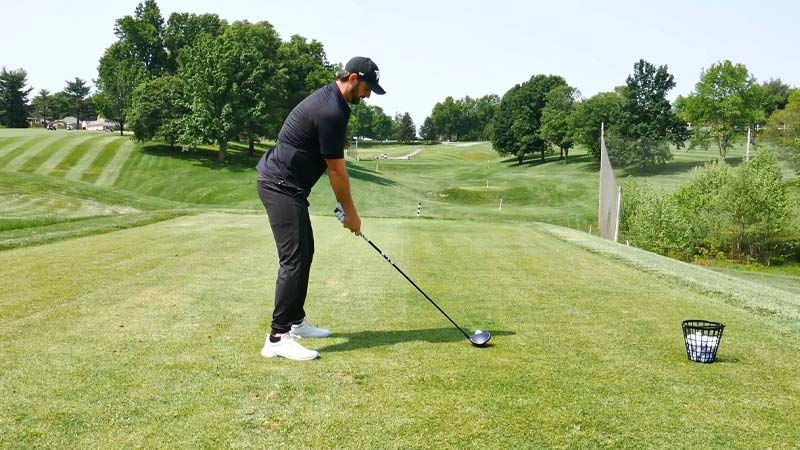
In golf, the proper angle and lean refer to the way you position your body and club during your swing to achieve the best results.
The angle and lean can vary depending on the club you’re using, and they play a significant role in controlling the trajectory and direction of your shots.
Here are some key concepts related to the proper angle and lean in golf:
Address Angle
Address angle refers to the initial angle of the clubface when you set up the ball.
For a driver, you typically want the clubface to have a slightly open or neutral angle at the address. This helps to promote a more sweeping, upward strike on the ball.
Clubshaft Lean
The club shaft lean refers to the angle formed between the shaft of the club and the ground at the address. With a driver, the club shaft should have a slight tilt away from the target, creating a positive angle of attack.
This tilt encourages the desired upward strike on the ball. The amount of shaft lean can vary depending on your setup, but a general guideline is to have the handle of the driver slightly ahead of the club head.
Spine Angle
Your spine angle is the tilt of your upper body from the hips. With a driver, you should have a slight tilt away from the target at the address.
This helps you create the proper angle of attack and encourages a more sweeping motion through the ball. Your spine angle should match the tilt of the club shaft.
Angle of Attack
The angle of attack refers to the angle at which the clubhead approaches the ball during the downswing.
With a driver, the goal is to have a positive angle of attack, meaning you are hitting the ball on the upswing. This helps to launch the ball high with lower spin, resulting in longer drives.
Dynamic Impact
As you swing through the ball, the dynamic impact position involves maintaining the proper clubshaft lean and body angles.
With a driver, you want to maintain a slightly upward angle of attack through impact, ensuring that you “hit up” on the ball.
Swing Path
The swing path is the direction in which your clubhead travels during the swing. With a driver, you typically want a slightly inside-out swing path. This promotes a draw or slight fade, which can maximize distance and control.
The proper angle and lean for your driver setup and swing may vary depending on your swing style and the specific adjustments you need to make for your unique characteristics.
It’s essential to work with a golf instructor who can analyze your swing and help you make the necessary adjustments to achieve the best results with your driver.
Additionally, practice and repetition are key to developing consistency in your swing.
Importance of Custom Fitting in Golf Driver Setup
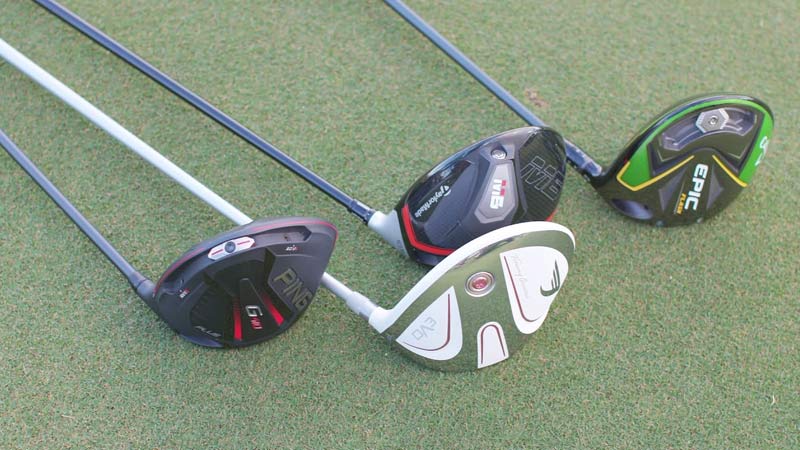
Custom fitting in golf is an essential process, and it is particularly crucial for the setup and selection of a golf driver.
Custom fitting helps golfers optimize their equipment to match their unique swing characteristics and preferences, ultimately leading to improved performance and enjoyment of the game.
Here are the key reasons why custom fitting is essential for a golf driver setup:
Maximizes Distance
Custom fitting takes into account your swing speed, launch angle, and spin rate to ensure that the driver’s specifications, such as loft, shaft flex, and shaft length, are tailored to your specific needs.
This results in maximizing the distance potential for your drives.
Improves Accuracy
Custom fitting helps you find a driver that suits your swing and promotes a more consistent and accurate ball flight. This can lead to hitting more fairways and avoiding penalties off the tee.
Enhances Consistency
A properly fitted driver can help you achieve a more consistent ball flight, which is essential for lowering your scores. A consistent setup with the right specifications ensures you deliver consistent results.
Increases Comfort and Confidence
A driver that’s custom-fit to your preferences and body characteristics is more comfortable to use, which can boost your confidence on the course.
When you have confidence in your equipment, it’s easier to focus on your swing and shot execution.
Reduces the Risk of Injury
Custom fitting also considers the physical aspects of your swing, such as your posture, swing plane, and any potential physical limitations.
This can help reduce the risk of injury or discomfort that can arise from using poorly fitted equipment.
Custom Shaft Selection
Finding the right shaft is a critical aspect of custom fitting. The correct shaft flex, weight, and kick point can significantly affect your ability to generate clubhead speed and control the clubface through impact.
Personalized Clubhead and Grip Selection
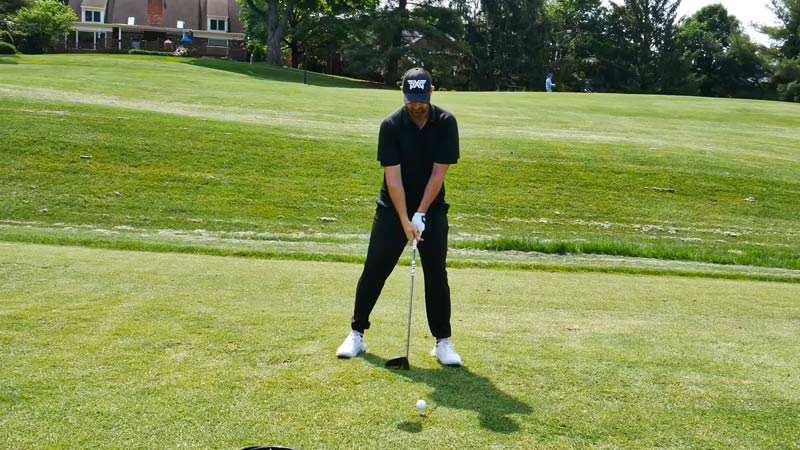
Custom fitting allows you to select a driver head that suits your visual preferences and addresses any specific performance requirements.
It also enables you to choose the right grip size and type for your hand size and feel preferences.
Optimal Trajectory
Custom fitting helps you fine-tune the launch angle and spin rate to create the optimal trajectory for your drives, ensuring that the ball stays in the air longer and carries farther.
Adaptation to Swing Changes
If your swing evolves or changes over time, custom-fitted equipment can be adjusted to accommodate those changes, providing a more consistent experience.
Investment in Your Golf Game
Golf clubs can be a significant investment, and custom fitting ensures that you get the most out of your investment by using clubs that are tailored to your game.
To benefit from custom fitting, work with a professional club fitter or golf instructor who can analyze your swing and recommend the best driver specifications for your individual needs.
It’s a valuable investment that can lead to improved performance and greater enjoyment on the golf course.
How Should Driver Head Sit on Ground?
When addressing the golf ball with a driver, the driver’s head should sit slightly above the ground, with the bottom of the clubhead hovering just off the turf. The driver should not sit flat on the ground.
Here’s how the driver’s head should be positioned:
The Leading Edge
The leading edge of the driver’s head, which is the bottom and front edge of the clubface, should be slightly above the ground. This ensures that the clubhead is not in direct contact with the turf when you address the ball.
Tee Height
You should be using a tee to elevate the golf ball above the ground. For a driver, tee the ball up so that about half of it is above the crown (top) of the clubhead.
This setup allows you to strike the ball on the upswing, which is crucial for maximizing distance and achieving an optimal launch angle with a driver.
Angle of Attack
The slight gap between the driver’s head and the ground is intentional, as it helps facilitate an upward angle of attack when you make your swing.
Hitting up on the ball promotes a higher launch and lower spin, which results in longer drives.
Personalization
The exact height at which the driver’s head sits above the ground can vary based on your setup and swing characteristics. Some golfers may prefer a slightly higher setup, while others may have a lower setup.
The key is to find the position that allows you to make solid contact with the ball and achieve the desired launch and spin characteristics.
It’s important to practice and experiment with your driver setup to find the right balance for your game.
Working with a golf instructor or club fitter can also help you fine-tune your driver setup to match your unique swing and optimize your performance off the tee.
FAQs
How should your driver sit on the ground?
Your driver should sit on the ground with the clubhead resting behind the ball. The shaft should be inclined slightly away from the target, and your grip and stance should be set up for your intended shot.
How should a golf club sit on the ground?
A golf club should sit on the ground with the clubhead touching the grass and the shaft pointing towards the target. The clubface should be square to the target line, and the grip should be positioned in your hands correctly.
How should my driver sit on the ground?
Your driver should sit on the ground with the clubhead positioned behind the ball. The shaft should angle slightly away from the target, and your grip, stance, and ball position should be tailored to your swing and shot shape.
How should a driver sit on the ground?
A driver should sit on the ground with the clubhead behind the ball, the shaft slightly tilted away from the target, and the grip, stance, and ball placement adjusted to your swing. This setup optimizes your driving performance.
How should a golf club sit on the ground?
A golf club should sit on the ground with the clubhead resting on the grass, the shaft aligned toward the target, and the clubface square to the target line. Your grip and stance should also be in the correct positions for your shot.
Wrapping Up
Your golf driver setup is your launchpad to those picture-perfect tee shots, and it’s vital to get it right.
By understanding the intricacies of tee height, clubhead positioning, and the nuances of your individual swing, you can fine-tune your driver setup to suit your game.
Remember that practice and personalization are key to mastering this essential aspect of golf.
Whether you’re aiming for greater distance, accuracy, or simply a more consistent swing, the way your driver sits on the ground plays a pivotal role.
Don’t be afraid to seek the guidance of a golf instructor or club fitter to help you dial in the perfect setup.
With the right knowledge and practice, you’ll be on your way to hitting those long, powerful drives that can make all the difference on the golf course.

